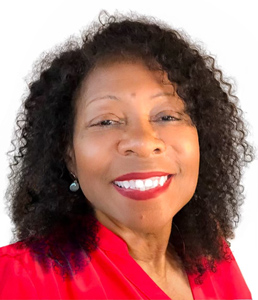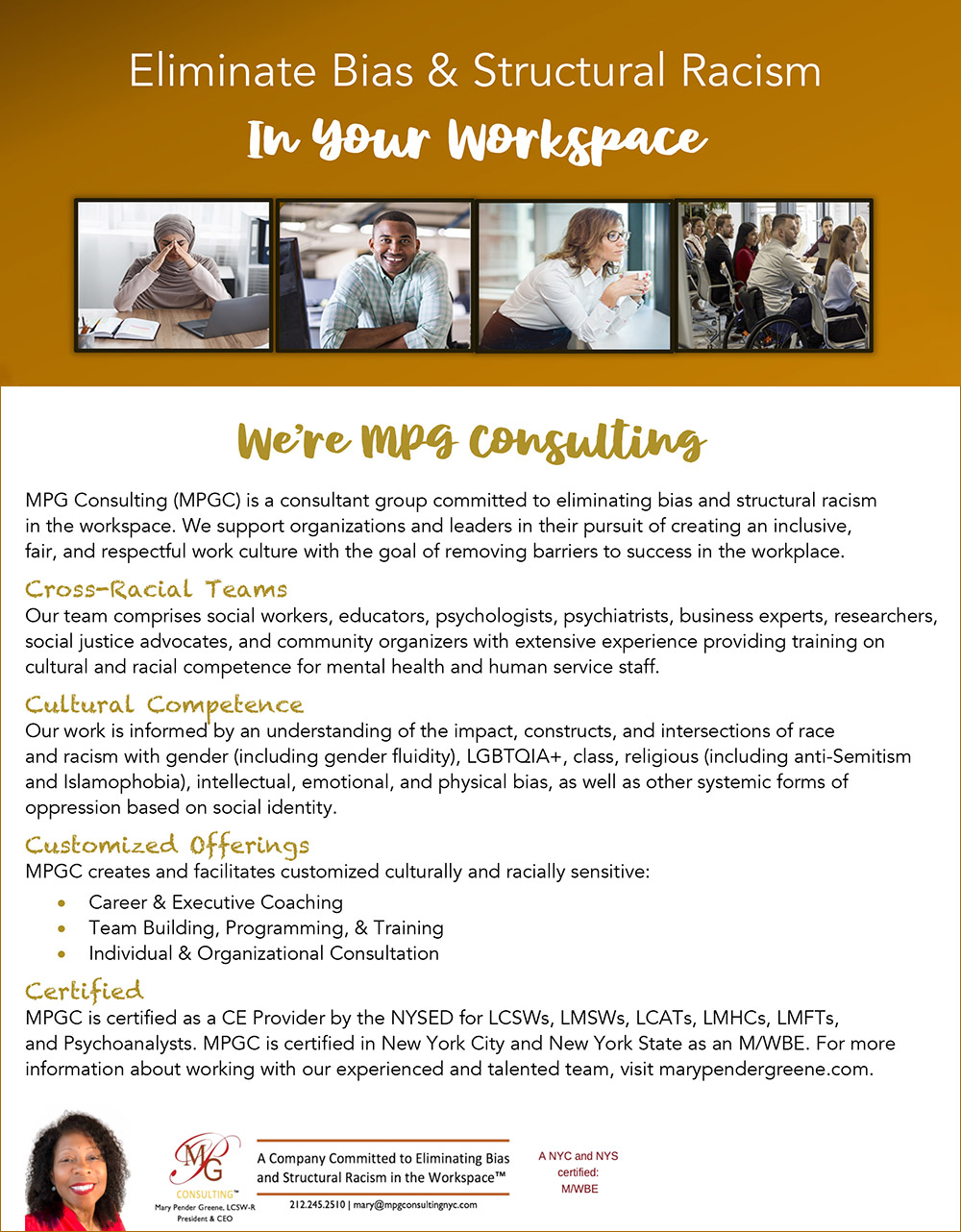White institutional culture is most often invisible. It determines the norms and standards in your organization and is damaging to the antiracist journey. It requires training your eyes to see, your ears to hear, and your voice to become racially fluent. The first step for an antiracist leader is to learn to become a critical lover of your organization, which means identifying barriers to achieving your goals of a fully inclusive workspace.

Mary Pender Greene, LCSW-R, CGP
Throughout my extensive career, I have held the roles of clinician, administrator, executive, coach and President & CEO of MPG Consulting, a company committed to eliminating bias and structural racism in the workspace. I have supported executives on the journey towards leading antiracist organizations create brave spaces for difficult conversations, an atmosphere of psychological safety, inclusiveness and belonging, and opportunities for systemic change.
Questions to Ask Yourself
- Are Black, Indigenous, and People of Color thriving in your institution?
- Are there Black, Indigenous, and People of Color in decision-making positions?
- What are the similarities/differences between those in decision-making positions and clients served?
- When there is a change in client demographics, are the decision makers actively seeking to be more closely aligned with and responsive to the change?
Barriers to Becoming an Antiracist Organization
“Check the Box” Mentality: These are shortcuts leaders sometimes make in their attempt to diversify the racial makeup of their organizations. Without the intent to make meaningful and long-lasting changes, there is an insufficient number of BIPOC in leadership roles who have the authority to make substantial changes to the organization. Under the guise of “progressive diversity work,” issues of bias, white-body privilege, and structural racism all remain invisible, free of scrutiny, and unexamined.
Favoritism: According to Dr. Nancy DiTomaso, the preferential treatment white leaders offer colleagues in their networks aggravates the racial inequality in our organizations (Cornell University, 2014). Their colleagues receive more opportunities and have more access to social and cultural capital. Due to the implicit nature of favoritism, many whites operate under the assumption that they made their way on their own, not acknowledging the advantage favoritism plays in their hires or promotions.
“Fit” (Cultural Similarities): “Fit” is code for cultural traits that match the dominant culture in body type, presentation style, and lived experience. Fit is a major barrier to advancing antiracist work within organizations as it is used as justification to exclude BIPOC from leadership positions.
Pipeline Problem: Discovering qualified BIPOC leaders and board members is as simple as developing cross-racial personal and professional relationships outside of your organization, asking BIPOC leaders, and seeking outstanding BIPOC currently on staff who may need some professional development and encouragement by their white leaders.
Lack of Psychological Safety: Psychological safety refers to “a shared belief that the team is safe for interpersonal risk taking” (Edmonson, 1999). BIPOC, specifically leaders, are discouraged from being their full selves or offer an authentic perspective to a situation due to underrepresentation, hypervisibility, and excessive scrutiny. Lack of psychological safety engenders conformity, a barrier to progressive decision-making, and meeting the organization’s antiracist goals.
Pockets of Resistance Against an Antiracist Organizational Change
According to Dolly Chugh in The Person You Mean to Be: How Good People Fight Bias, bias impacts:
- Hiring
- Promotions
- Potential leaders
- Who is heard and valued
- Who is trusted, supported, rewarded
- Who is favored and given the benefit of the doubt when a mistake is made
- Who is oppressed by over supervision and suspicion
- Who is burdened by conscious and unconscious racial biases, stereotypes, and judgments
When leaders allow pockets of resistance to go unchecked due to their personal biases, the antiracist work stalls and BIPOC staff are harmed. It is crucial for antiracist leaders to hold all staff accountable, no matter their tenure and level of authority in the organization.
Racial inequities are deeply baked into our systems. The most important tip for all antiracist leaders is to commit to the journey for the long haul, for yourself, your network, your organization, and your community. The antiracist journey is eternal.
Things to Do to Increase Racial Literacy
1) Develop authentic relationships with BIPOC outside and inside of your organization – Some ideas for building authentic relationships include:
- Walking Lunch with BIPOC colleagues
- Join professional groups where you are in the minority
- Develop or deepen a personal cross-racial friendship
2) Participate – Take the Undoing Racism™ Workshop: The Undoing Racism™ Workshop is a unique two-and-a-half-day workshop by The People’s Institute for Survival and Beyond, a national network from New Orleans, dedicated to ending racism and other forms of institutional oppression. (It changed my life and my practice). – pisab.org
3) Attend – What White People Can Do About Racism – The Center for the Study of White American Culture – contact@euroamerican.org
4) Take – Specialized Training in Anti-Racist Work for White People and White Helping Professionals
Irene Greene– www.irenegreene.com
5) Join – The Undoing Racism™ Executive Collective Virtual Gathering. This group is designed for people in senior leadership roles in their organizations, particularly executive directors and who have substantial decision-making authority and are invested in nurturing their organizations to become more equitable, just, and antiracist institutions. Others are also welcome. Learn from speakers, obtain resources, and gather with peers to grapple collectively and honestly with the challenges antiracist leaders frequently encounter. To be added to email list, contact: mpgconsultingnyc@gmail.com First Monday of Every Month, 9am-11am | Zoom Gathering (No Cost)
6) Read – The Person You Mean to Be: How Good People Fight Bias by Dolly Chugh – “Becoming an Antiracist Leader: From the View of a Black Female Clinician and Consultant” and The Enduring, Invisible, and Ubiquitous Centrality of Whiteness by Kenneth V. Hardy, PhD
Mary Pender Greene, LCSW-R, CGP, is President & CEO of MPG Consulting. For more information, visit www.marypendergreene.com, email mary@mpgconsultingnyc.com, or call (212) 245-2510.
References
Borysenko, K. (2018, September 30). How to create your own psychological safety at work. Forbes. https://www.forbes.com/sites/karlynborysenko/2018/09/30/create-your-own-psychological-safety-work/?sh=20ef989051ef
Cheeks, M. (2018, March 26). How black women describe navigating race and gender in the workplace. Harvard Business Review. https://hbr.org/2018/03/how-black-women-describe-navigating-race-and-gender-in-the-workplace
Chugh, D., & Bock, L. (2018). The person you mean to be: How good people fight bias. HarperCollins.
Cornell University. (2014, March 20). The American non-dilemma: Racial inequality without racism [Video]. YouTube. https://www.youtube.com/watch?v=U_NeqTjz13Q
Edmondson, A. (1999). Psychological safety and learning behavior in work teams. Administrative Science Quarterly, 44(2), 350–383. https://doi.org/10.2307/2666999
Heath, K., & Wensil, B. F. (2019, September 6). To build an inclusive culture, start with inclusive meetings. Harvard Business Review. https://hbr.org/2019/09/to-build-an-inclusive-culture-start-with-inclusive-meetings
Kunreuther, F. and Thomas-Breitfeld, S. (2020). Race to Lead Revisited: Obstacles and Opportunities in Addressing the Nonprofit Racial Leadership Gap. https://racetolead.org/race-to-lead-revisited/
North, A. (2010). “Bias Effects.” Performance Appraisal. http://www.performance-appraisal.com/bias.htm
NYU School of Law. (2019, November 18). Katherine W. Phillips on understanding the value of diversity [Video]. YouTube. https://www.youtube.com/watch?v=gHFwoBQB5i4
Pender Greene, M. (2022). Becoming an Antiracist Leader: From the View of a Black Female Clinician and Consultant. In K. Hardy (Ed.), The Enduring, Invisible, and Ubiquitous Centrality of Whiteness (pp. 371-404). Norton Professional Books.
Pender Greene, M. (October 1, 2017). Vulnerable Populations: People of Color in Leadership Roles. Behavioral Health News. https://behavioralhealthnews.org/vulnerable-populations-people-of-color-in-leadership-roles-2/
Rivera, L. A. (2012). Hiring as cultural matching: The case of elite professional service firms. American Sociological Review, 77(6), 999–1022. https://doi.org/10.1177/0003122412463213
Rivera, L. A. (2020, August 4). Stop hiring for “cultural fit.” KelloggInsight. https://insight.kellogg.northwestern.edu/article/cultural-fit-discrimination
Rosette, A. S., & Livingston, R. W. (2012). Failure is not an option for black women: Effects of organizational performance on leaders with single versus dual-subordinate identities. Journal of Experimental Social Psychology, 48(5), 1162–1167. https://doi.org/10.1016/j.jesp.2012.05.002
Sesko, A. K., & Biernat, M. (2010). Prototypes of race and gender: The invisibility of black women. Journal of Social Psychology, 46(2), 356–360. https://doi.org/10.1016/j.jesp.2009.10.016







